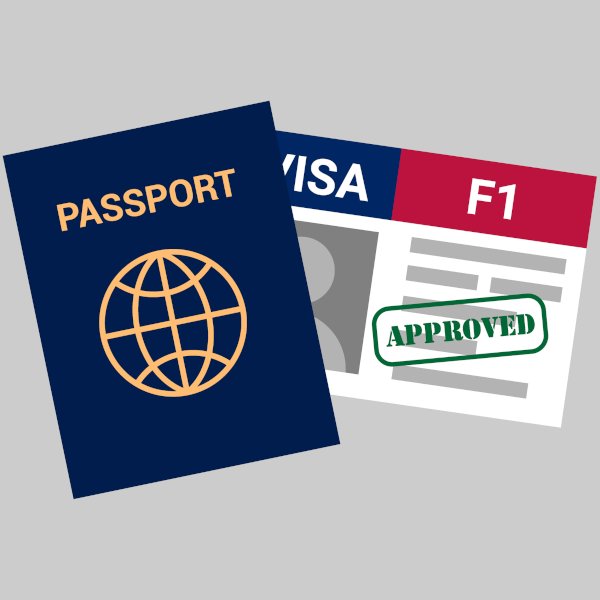What is an F1 Visa?
What is an F1 visa?
An F1 visa is a nonimmigrant visa for those wishing to study in the U.S. You must file an F1 visa application if you plan on entering the US to attend a university or college (for a degree), high school, private elementary school, seminary, conservatory, language training program, or other academic institution.This article was designed to help international students and their families understand all the details about the F1 visa, the application process and how to qualify for it.
There are a few exceptions, but in general, anyone who intends to stay in the USA to study or live must obtain either a temporary or immigrant visa by the US Department of State. If you wish to study in the USA, you will most typically be issued a non-immigrant visa called an F1 (F2 for dependents) and can choose to attend one of the school types that are listed above.

How Do You Get an F1 Visa?
The F1 visa process is relatively simple but can be time consuming, so it’s important to start this process as soon as possible to ensure that any delays won’t affect your education. Perhaps one of the lengthiest steps towards becoming an international student can be applying to a US school that has been approved by the Student and Exchange Visitor Program (SEVP). It’s also important to keep in mind that, while there are many great institutions across the country, not all are approved by SEVP to accept international students, so it’s important to verify that the school you would like to attend is approved well before filling out any applications, writing any essays, or providing references.
After being accepted by the school of your choice, you will be officially enrolled into the SEVP and are required to pay the SEVIS I-901 Fee. After all fees are paid and your account is in good standing, an I-20 form will be provided by your institution or educational program. The I-20 is an official immigration document, signed by your university’s Designated School Official (DSO), that lists your school name, your program dates, your financial obligations, and your educational program information. You will use your SEVIS Number (found on the I-20 form) to schedule an interview appointment with a local US embassy or consulate, after which you will (hopefully) be granted an F1 visa and officially become an international student!
F1 Visa Qualifications
Specific instructions for how to apply for your F1 visa will be listed on the website of the US embassy or consulate that you plan on visiting; but regardless of where your visa appointment may take place, you will need to provide the same kind of documents and address the same kinds of questions.
In order to qualify and as part of the F1 visa interview process, potential international students will need to prove the following:
- Official Residency in a Foreign Country and Intentions to Return Home
- Upon graduation, it’s imperative that the international student plans on returning back to their home country. If an interviewer can tell that your intentions are to become a permanent resident of the United States, your visa will more than likely be denied. The intention of a student visa is to further educate yourself and then bring your newfound knowledge back to your country of citizenship, not to remain in the US.
- Admission to an Approved School
- During your interview, it is also imperative that you can prove acceptance by a US institution or language school approved by the SEVP.
- Sufficient Financial Support
- F1 visa holders must be equipped to cover their living and study expenses while in the US, as legal employment opportunities will be limited. The amount you’ll be responsible for proving will be listed on your I-20 (and will have already been required to prove to your institution in order to obtain your I-20).
- Ties to Your Home Country
- Another important part of an F1 visa interview is proving strong ties to your home country, including family, job offers, bank accounts or other assets.

Working on an F1 Visa
It’s essential to remember that F1 visas are intended for full-time students and are not designed as work visas. Working illegally while on an F1 visa is a serious violation of the regulations, and could result in deportation. With this in mind, international students are typically able to work up to 20 hours a week on campus when school is in session and up to 40 hours a week while school is in recess (such as summer), but you may need to seek approval from the Department of Homeland Security and the International Office at your school first. You should always check with the International Office about what is considered an “on campus” job versus an “off campus” job.
In order to work off-campus, F1 visa holders must apply for “work authorization” through their DSO and USCIS. There are three main types of work authorization for F1 students: Curricular Practical Training (CPT), Optional Practical Training (OPT), and Severe Economic Hardship (SEH).
Curricular Practical Training (CPT) is work authorization that is designed for students who need to complete an internship or other work experience as part of their educational program. The regulations for CPT are nuanced and the rules vary greatly from institution to institution. If you are interested in pursuing CPT, you should talk with your DSO to understand the process on your campus.
Severe Economic Hardship (SEH)is reserved for those students who meet very strict criteria for “economic hardship,” such as parents living in a war torn country or support system affected by a natural disaster. If authorized for SEH, the student is permitted to work a certain number of hours off-campus (in a job unrelated to their major) in order to offset the financial challenges and help cover their expenses while in the US.
The most popular and straightforward form of F1 work authorization is Optional Practical Training. F1 visa holders who have completed at least one academic year of school are eligible to apply for pre-completion or post-completion OPT. Pre-completion OPT is done before graduation, while post-completion OPT is done after graduation. Students are eligible for a full 12 months, typically, and can split these up between pre-completion and post-completion–though most students reserve all of their OPT time for post-completion. Keep in mind that full-time CPT may also impact your OPT time, so check with your DSO!
OPT allows F1 students to train, and thus work, in a job that is directly related to their major field of study. For more information, be sure to contact an international student advisor at your school, since applying for OPT requires a new I-20 from your DSOTransferring Schools with an F1 Visa
Students on an F1 visa are required to study at the academic institution through which their visa application was filed and granted and their current I-20 was issued. However, in some situations, international students are able to transfer institutions if the student completes or leaves their current program with confirmed plans to study at a different US institution the following academic semester. You’ll need to work closely with the international student offices at both institutions to complete their transfer process for international students.
Returning Home
Students are not required to immediately return home upon completion of their program on an F1 visa. Instead, F1 visa holders can remain in the US for up to 60 days after completing their academic program or OPT training. This is called the “grace period.” Any students wishing to remain in the States after the grace period must change their visa status, re-enroll in anothereducation program, or transfer to a new school.
If you have any questions about the visa process, the international student office or the international student admissions contact should be your primary resource. If you’re not sure who to talk to, you can ask your school who the PDSO or DSO is. In terms of ensuring you have adequate health insurance for your studies in the United States, be sure to contact us for plan suggestions and guidance.